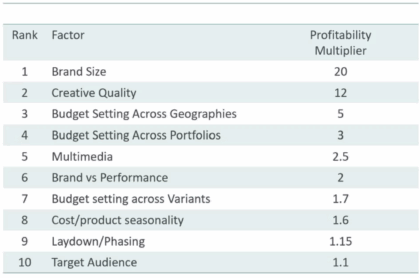In today’s AI‑powered media environment, paid advertising must be grounded in marketing science. Brand growth relies on reaching occasional buyers, reinforcing distinctive brand signals, and making purchase simple at scale. These principles remain unchanged, but recent data shows AI can enable more precise execution, making experimentation essential alongside your core media investment.
When media planning, follow these 5 principles that will deliver more effective advertising:
1. Balance brand and performance
Remember, conversions consistently come from occasional light buyers, not just loyal customers (think Coca Cola or McDonalds!), so most brands depend more on light users. In the annual Gartner CMO Spend Survey conducted this year we’ve seen marketing budgets averaged 7.7% of revenue globally, meaning for every £100 of revenue, £7.70 is being re-invested into marketing. This budget should support strategic longer-term campaigns that are blending upper-funnel, brand-building, activity with performance tactics to maintain momentum and reach net new buyers.
Action: Combine upper-funnel brand-building campaigns (video, audio, connected TV, OOH) with performance marketing to grow both reach and measurable return.
2. Use distinctive creative
Use creative to stand out from the crowd. Visual and audio assets (logos, colours, jingles, typography) boost brand recall by 80%+ and choice by 70% however only 15% of assets meet true gold-standard distinctiveness. AI-powered creative tools can help create content that stands out while retaining the core brand elements.
Action: Explore how to best integrate AI creative platforms to deploy test campaigns that feature your most distinctive brand signals in every format.

Advertising Profitability Analysis, 2023, Paul Dyson
3. Stay consistent
Integrated campaigns deliver up to 3X the effectiveness of siloed ones. At the same time, testing is critical to find what works best. AI features allow controlled experimentation in channels like Google and Meta with different versions of copy, creative and placements without diluting brand identity.
Action: Set up structured A/B tests in ad platforms to fine-tune headlines, images and audiences while keeping core brand assets consistent.
4. Be visible to potential (future) buyers
If you’re in B2B marketing, only 5% of buyers are actively looking to buy at any time; the rest are passive (and should be treated as future customers!) . Broad reach increases mental availability, making your brand more likely to be chosen when a need arises. AI-driven broad-match and predictive targeting can help extend reach beyond current customers.
Action: Test the incremental lift of AI-enhanced targeting across search, display and social to expand reach and increase presence with those not yet in the active consideration stage of the user journey (bonus points if you have segmentation in 1st party data!).
5. Orchestrate across channels
AI-backed media mix and attribution tools working together can outperform manual planning if combining real-time optimisation with insights derived from real data analysis. These tools use actual performance data over time to fine-tune strategies, boosting efficiency and ensuring consistent growth over time (not limited to one channel).
Action: Implement a level of cross-channel attribution and optimisation through tools that integrate a mix of AI and data insights, this will strengthen campaigns and keep consistency across platforms.
Spend to Experiment (or Risk Falling Behind)
In 2025, brand marketers face flat budgets, yet most are still prioritising growth by reallocating resources to AI and experimentation to compensate. Generative AI adoption across sales and marketing nearly doubled between 2023 and 2024, so structured experimentation will make the difference between running yesterday’s campaigns well and discovering tomorrow’s engines of growth.
Action: Earmark an innovation budget by dedicating 5-10% of all media spend to piloting new formats, tools and AI capabilities so you can learn quickly, fail fast. and adapt without disrupting your core performance.
 Think With Google
Think With Google
The fundamentals of paid media remain constant: reach, distinctiveness, and availability. Incorporating AI can now offer smarter ways to achieve these aims at scale on all your core platforms. By combining proven marketing principles with disciplined experimentation you will ensure your paid media is both effective now and resilient in the future. If you’re worried about tracking performance of your experiments effectively, check out Jonathan’s blog on server-side tracking.


